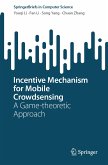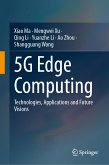Toward Connected, Cooperative and Intelligent IoV (eBook, PDF)
Frontier Technologies and Applications


Alle Infos zum eBook verschenken

Toward Connected, Cooperative and Intelligent IoV (eBook, PDF)
Frontier Technologies and Applications
- Format: PDF
- Merkliste
- Auf die Merkliste
- Bewerten Bewerten
- Teilen
- Produkt teilen
- Produkterinnerung
- Produkterinnerung

Hier können Sie sich einloggen

Bitte loggen Sie sich zunächst in Ihr Kundenkonto ein oder registrieren Sie sich bei bücher.de, um das eBook-Abo tolino select nutzen zu können.
This book offers a comprehensive introduction to technological advances in Internet of Vehicles (IoV), including vehicular communications, vehicular system architectures, data dissemination algorithms, resource allocation schemes, and AI-enabled applications. It focuses on the state-of-the-art IoV with regard to three major directions, namely networking, cooperation, and intelligence, including advanced wireless communication technologies, algorithm theory, optimization mechanisms, and AI technologies. In addition, the book includes a number of case studies with system prototype implementation…mehr
- Geräte: PC
- ohne Kopierschutz
- eBook Hilfe
- Größe: 23.72MB
![Incentive Mechanism for Mobile Crowdsensing (eBook, PDF) Incentive Mechanism for Mobile Crowdsensing (eBook, PDF)]() Youqi LiIncentive Mechanism for Mobile Crowdsensing (eBook, PDF)40,95 €
Youqi LiIncentive Mechanism for Mobile Crowdsensing (eBook, PDF)40,95 €![Edge Computing Resilience (eBook, PDF) Edge Computing Resilience (eBook, PDF)]() Yanlong ZhaiEdge Computing Resilience (eBook, PDF)36,95 €
Yanlong ZhaiEdge Computing Resilience (eBook, PDF)36,95 €![Location, Localization, and Localizability (eBook, PDF) Location, Localization, and Localizability (eBook, PDF)]() Yunhao LiuLocation, Localization, and Localizability (eBook, PDF)129,95 €
Yunhao LiuLocation, Localization, and Localizability (eBook, PDF)129,95 €![Multi-dimensional Urban Sensing Using Crowdsensing Data (eBook, PDF) Multi-dimensional Urban Sensing Using Crowdsensing Data (eBook, PDF)]() Chaocan XiangMulti-dimensional Urban Sensing Using Crowdsensing Data (eBook, PDF)137,95 €
Chaocan XiangMulti-dimensional Urban Sensing Using Crowdsensing Data (eBook, PDF)137,95 €![WiFi signal-based user authentication (eBook, PDF) WiFi signal-based user authentication (eBook, PDF)]() Jiadi YuWiFi signal-based user authentication (eBook, PDF)36,95 €
Jiadi YuWiFi signal-based user authentication (eBook, PDF)36,95 €![5G Edge Computing (eBook, PDF) 5G Edge Computing (eBook, PDF)]() Xiao Ma5G Edge Computing (eBook, PDF)129,95 €
Xiao Ma5G Edge Computing (eBook, PDF)129,95 €![Complementarity: Applications, Algorithms and Extensions (eBook, PDF) Complementarity: Applications, Algorithms and Extensions (eBook, PDF)]() Complementarity: Applications, Algorithms and Extensions (eBook, PDF)113,95 €
Complementarity: Applications, Algorithms and Extensions (eBook, PDF)113,95 €-
-
-
Dieser Download kann aus rechtlichen Gründen nur mit Rechnungsadresse in A, B, BG, CY, CZ, D, DK, EW, E, FIN, F, GR, HR, H, IRL, I, LT, L, LR, M, NL, PL, P, R, S, SLO, SK ausgeliefert werden.
Hinweis: Dieser Artikel kann nur an eine deutsche Lieferadresse ausgeliefert werden.
- Produktdetails
- Verlag: Springer Nature Singapore
- Seitenzahl: 327
- Erscheinungstermin: 14. März 2024
- Englisch
- ISBN-13: 9789819996476
- Artikelnr.: 70179884
- Verlag: Springer Nature Singapore
- Seitenzahl: 327
- Erscheinungstermin: 14. März 2024
- Englisch
- ISBN-13: 9789819996476
- Artikelnr.: 70179884
- Herstellerkennzeichnung Die Herstellerinformationen sind derzeit nicht verfügbar.
Kai Liu is currently a professor in the College of Computer Science, and in the National Elite Institute of Engineering, Chongqing University, China. He received his PhD degree in Computer Science from the City University of Hong Kong in 2011. From December 2010 to May 2011, he was a visiting scholar with the Department of Computer Science, University of Virginia, USA. From 2011 to 2014, he was a postdoctoral fellow with Singapore Nanyang Technological University, City University of Hong Kong, and Hong Kong Baptist University. His research interests include internet of vehicles, mobile computing, and pervasive computing.
Penglin Dai is currently an associated professor with the School of Computing and Artificial Intelligence, Southwest Jiaotong University, Chengdu, China. He received the BS degree in mathematics and applied mathematics and the PhD degree in computer science from Chongqing University, Chongqing, China, in 2012 and 2017, respectively.His research interests include intelligent transportation systems and vehicular cyber-physical systems.
Victor Lee is currently a lecturer in the Department of Electrical and Electronic Engineering at the University of Hong Kong. Before joining HKU, he was an assistant professor in the Department of Computer Science at the City University of Hong Kong. He has been a research fellow in CityU in 1997, a visiting research associate in the University of Virginia in 1999, and a visiting scholar in the Department of Computer Science and Information Engineering of National Taiwan University in 2008. He received his BSc, MPhil, and PhD in Computer Science all from the City University of Hong Kong. His research interests include intelligent transportation systems, vehicular networks, e-learning, machine learning, and real-time databases.
Joseph Kee-Yin Ng is a full professor and the director of the Research Centre for Ubiquitous Computing in the Department of Computer Science. He is also the program director of BSc in Business Computing and Data Analytics program and the former program director of the BSc in Computer Science program. He received his BSc, MSc, and PhD degree in Computer Science from the University of Illinois at Urbana-Champaign. His current research interests include real time and embedded systems, cyber-physical systems, Internet of Things, wireless communications, and ubiquitous/pervasive computing, location-aware computing, and mobile and ubiquitous healthcare.
Sang Hyuk Son is currently a full professor with the Daegu Gyeongbuk Institute of Science and Technology. He received the BS degree in electronics engineering from Seoul National University, the MS degree from the Korea Advanced Institute of Science and Technology (KAIST), and the PhD degree in computer science from the University of Maryland, College Park, MD, USA. He has been a professor with the Computer Science Department, University of Virginia,and the WCU chair professor with Sogang University. He has been a visiting professor with KAIST, the City University of Hong Kong; the Ecole Centrale de Lille, France; Linköping University; and the University of Skövde, Sweden. He has authored or coauthored over 340 articles and edited/authored four books in his research areas. His research interests include cyber-physical systems, real-time and embedded systems, database and data services, and wireless sensor networks. He is a member of the Korean Academy of Science and Technology and the National Academy of Engineering of Korea. He is a founding member of the ACM/IEEE CPS Week. He received the Outstanding Contribution Award from the Cyber-Physical Systems Week in 2012. He has served on the editorial board of the ACM Transactions on Cyber-Physical Systems, the IEEE Transactions on Computers, the IEEE Transactions on Parallel and Distributed Systems, and Real-Time Systems Journal.







